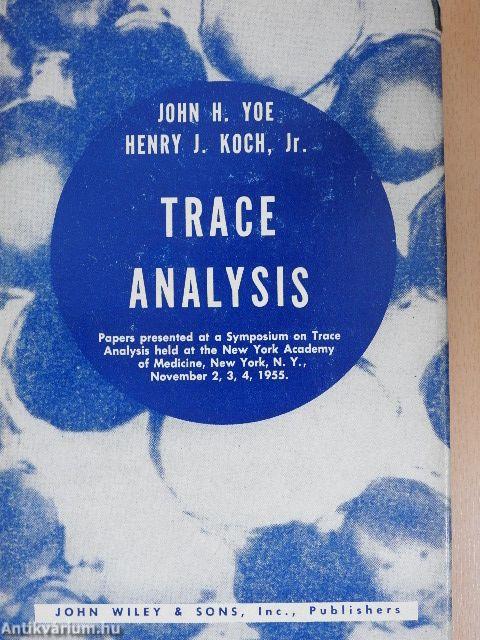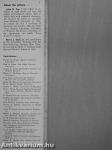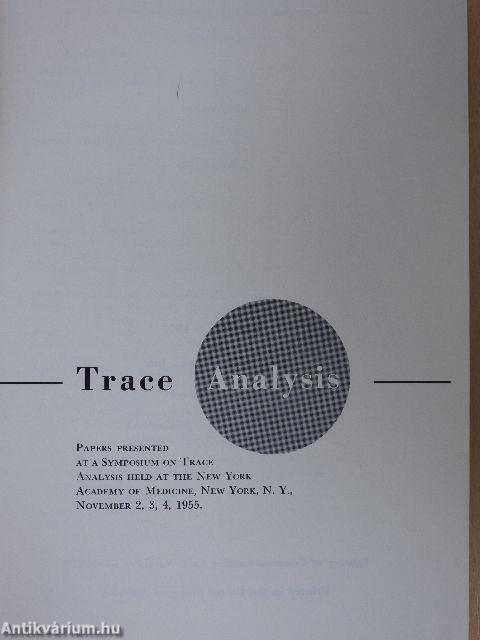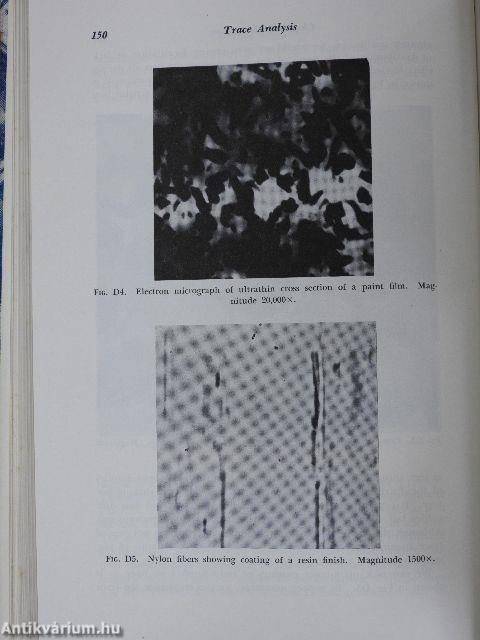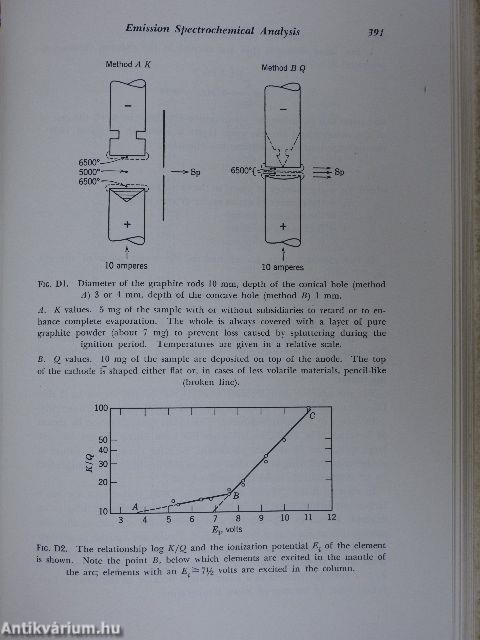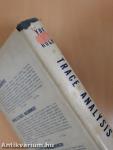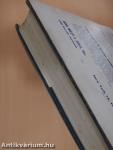1.067.073
kiadvánnyal nyújtjuk Magyarország legnagyobb antikvár könyv-kínálatát

VISSZA
A TETEJÉRE
JAVASLATOKÉszre-
vételek
Trace Analysis
Papers Presented at a Symposium on Trace Analysis Held at the New York Academy of Medicine, New York, N. Y., November 2, 3, 4, 1955.
| Kiadó: | John Wiley & Sons, Inc.-Chapman & Hall, Limited |
|---|---|
| Kiadás helye: | New York-London |
| Kiadás éve: | |
| Kötés típusa: | Vászon |
| Oldalszám: | 672 oldal |
| Sorozatcím: | |
| Kötetszám: | |
| Nyelv: | Angol |
| Méret: | 24 cm x 16 cm |
| ISBN: | |
| Megjegyzés: | További kapcsolódó személyek a könyvben. Fekete-fehér ábrákkal, fotókkal. |
naponta értesítjük a beérkező friss
kiadványokról
naponta értesítjük a beérkező friss
kiadványokról
Előszó
TovábbFülszöveg
If:
THERAPEUTIC USE OF ARTIFICIAL RADIOISOTOPES
Edited by Paul F. Hahn, Meharry Mediad College, Nitshville, Tennessee. Twenty-nine research specialists contribated to this modern, authoritative guide to the treatment of virtually all benign and malignant conditions which are susceptible to handling with radioactive isotopes. The work gives convenient access to a wealth of material previously scattered throughout the medical literature of the world. It serves as a useful summary of accomplishments to date and should provide a valuable stimulus for future research. "We find it comprehensive, authoritative, and eisy to read. It is a very worthwhile addition to the literature on the clinical use of radioisotopes." — Oscar M. Bizzell, U. S. Atomic Energy Commission. I 1956. 414 pages. 148 illus.
APPLIED ELECTRICAL MEASUREMENTS
By Isaac Fern Kinnard, General Electric Company. With 14 contributors. Explores the basic principles behina commonly employed electrical measurement devices.... Tovább
Fülszöveg
If:
THERAPEUTIC USE OF ARTIFICIAL RADIOISOTOPES
Edited by Paul F. Hahn, Meharry Mediad College, Nitshville, Tennessee. Twenty-nine research specialists contribated to this modern, authoritative guide to the treatment of virtually all benign and malignant conditions which are susceptible to handling with radioactive isotopes. The work gives convenient access to a wealth of material previously scattered throughout the medical literature of the world. It serves as a useful summary of accomplishments to date and should provide a valuable stimulus for future research. "We find it comprehensive, authoritative, and eisy to read. It is a very worthwhile addition to the literature on the clinical use of radioisotopes." — Oscar M. Bizzell, U. S. Atomic Energy Commission. I 1956. 414 pages. 148 illus.
APPLIED ELECTRICAL MEASUREMENTS
By Isaac Fern Kinnard, General Electric Company. With 14 contributors. Explores the basic principles behina commonly employed electrical measurement devices. Sufficient theory is given for the intelligent application of these principles to the measurement of electrical and non-electrical quantities. "In summary, the book is well planned and its material is clearly presented and logically arranged. It thoroughly covers the art of applied electrical measurements as practiced in present-day technology, and would be a valuable addition to the library of any experimental worker in physics or engineering." — Forest K. Harris in Review of Scientific Instvuments. One of a series written by General Electric authors for the advancement of engineering practice.
1956. 600 pages. 417 illus.
STERIC EFFECTS SN ORSANIC CHEMISTRY
Edited hy Mel^'in S. Newman, Ohio State Unive.sity. Twelve auth.-^ri-ties contribute their specialized knowledge to this volumo which emphasizes the influence of steric factors on the reactivity and properties of molecules. "This volume should serve as an exccJlent reference work, source of background material, and introductioi into the literature of steric effects for teachers and laboratory workers at all levels of organic and pharmaceutical chemistry. It should be available in all pharmacy libraries." — Gustav E. Cwalina ia American Journal of Pharmaceutical Education.
1956. 710 pages. Illus.
JOHN WILEY & SOHS, Inc.
440 Fourth Avenue New York 16, N. Y.
About the book . . .
Written by 24 contributors — all recognized leaders in their respective fields of analysis — this book brings together all or most of the methods and techniques used in trace analysis.
The work is based on the first symposium devoted exclusively to the whole field of trace analysis: methodology, instrumentation, separations, concentrations, and contamination hazards in dealing with sub-microgram quantities. Each chapter is followed by a discussion, prepared by a discussion leader, which also includes pertinent comments from the floor made at the time of the symposium.
The papers deal with the theory, application, sensitivity, precision, accuracy, sources of error, advantages, limitations, etc. of the various methods and techniques employed in working trace analysis.
Many references are given to original papers where details of theory, procedures, apparatus, applications, etc. will be found. Selected references to books on specific subjects are also provided.
About the editors . . .
John H. Yoe is the author or coauthor of eight books and over 300 papers and technical reports, m6st of which deal with analytical chemistry. He received his Ph.D. in chemistry from Princeton University in 1923. At present Dr. Yoe is professor of chemistry and director, John Lee Pratt Trace Analysis Laboratory, University of Virginia. He ser^'ed as chairman of the symposium on which Trace Analysis is based.
Henry J. Koch, Jr. was coordinator of the symposium. Formerly with the Sloan-Kettering Institute, New York, he received his M.D. in medicine from Harvard Medical School in 1943.
Contributors . . .
Harold H. Strain, Argonne National
Laboratory Kurt A. Kraus, Oak Ridge National Laboratory
Lyman C. Craig, Rockefeller Institute for
Medical Research Walter C. McCrone, Armour Research
Foundation Fritz Feigl, Laboratorio da Producao
Mineral. Rio de Janeiro. Brazil Philip W. West, Louisiana State University M. G. Mellon, Purdue University Charles E. White, University of Maryland Bert L. Vallee. Harvard Medical School and Peter Brent Brigham Hospital, Boston, Mass.
N. Howell Furman, Princeton University Lockhart B. Rogers. Massachusetts Institute
of Technology Paul Delahay, Louisiana State University Charles N. Reilley, University of North Carolina
Lester W. Strock, Sylvania Electric Products, Inc.
Robert L. Mitchell, Macaulay Institute for
Soil Research, Aberdeen, Scotland H. W. Koch. Sloan-Kettering Institute Mark G. Inghram, University of Chicago Theodore Hall, Sloan-Kettering Institute Arne Engströni, Karolinska Institut et.
Stockholm, Sweden A. A. Smales, Atomic Energy Research Establishment, Harwell, Berkshire, England
Esmond E. Snell. University of California, Berkeley
Ralph H. Müller. Los Alamos Scientific Laboratory
W. Wayne Meinke, University of Michigan Ralph E. Thiers, Harvard Medical School
!
: ^ ¦ ^ ' /, I
/ ^ i. Vissza
Témakörök
- Idegennyelv > Idegennyelvű könyvek > Angol > Természettudományok > Kémia
- Idegennyelv > Idegennyelvű könyvek > Angol > Orvostudomány
- Természettudomány > Kémia > Kísérletek, gyakorlatok > Általában
- Természettudomány > Kémia > Idegennyelvű
- Természettudomány > Kémia > Társtudományok > Orvosi kémia
- Orvostudomány > Általános orvosi, egyéb > Idegennyelvű
- Orvostudomány > Általános orvosi, egyéb > Kutatások, kísérletek
- Orvostudomány > Általános orvosi, egyéb > Társtudományok > Kémia
- Orvostudomány > Orvosi idegennyelvű könyvek > Általános orvosi



